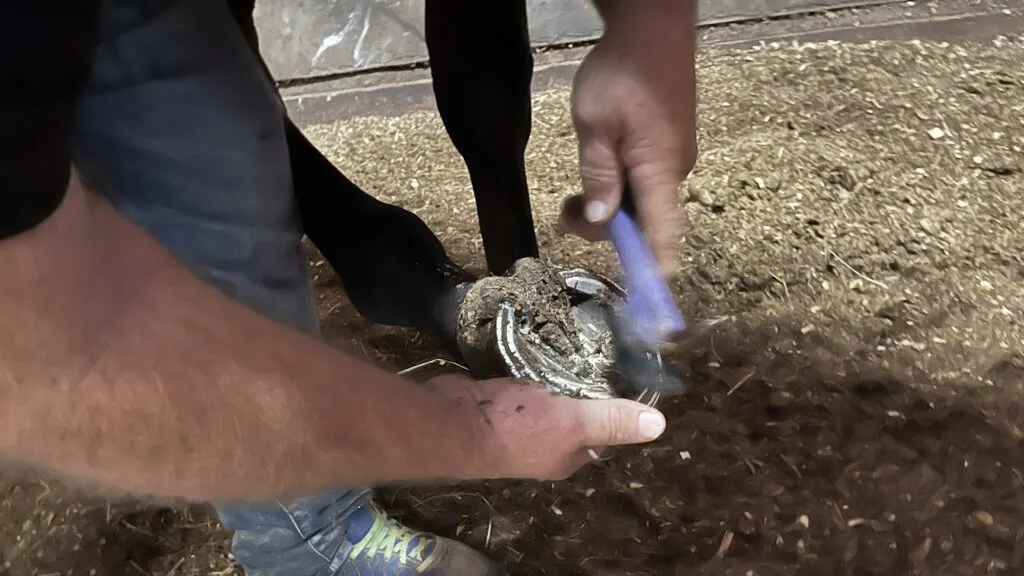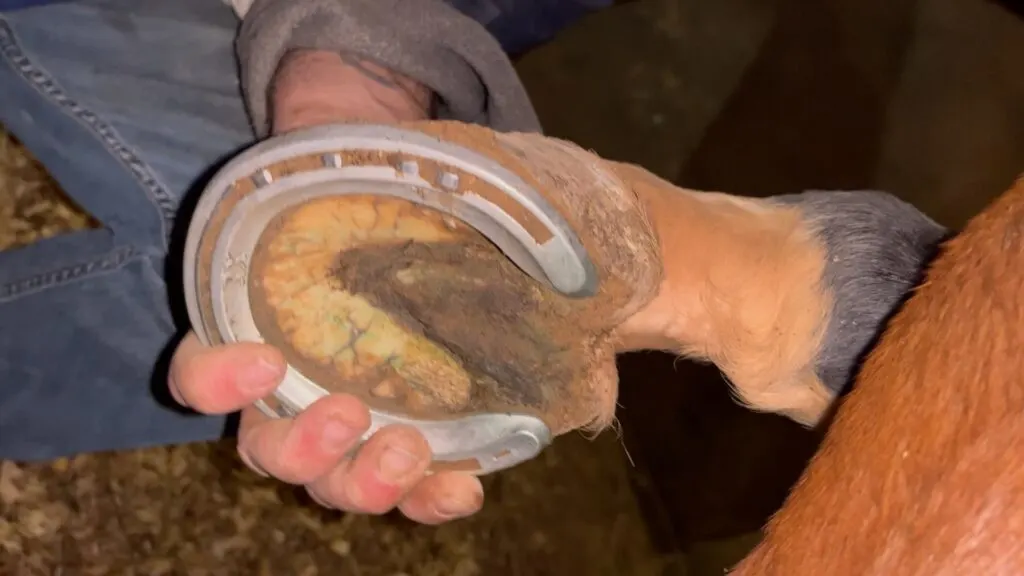Last updated: January 24, 2024
Any links on this page that lead to products on Amazon are affiliate links and I earn a commission if you make a purchase. Thanks in advance – I really appreciate it!
Is it safe to ride a horse with thrush? This question, crucial for horse enthusiasts, often depends on the severity of the infection. As a seasoned racehorse owner and author of two books on equine care, I’ve frequently faced this challenge. Thrush, a common foot infection in horses, presents varying degrees of concern.
In cases of mild thrush, riding might still be on the table, but when it comes to severe thrush, rest and proper treatment are non-negotiable. This article aims to provide a comprehensive guide on identifying, treating, and preventing thrush in horses. Drawing from my extensive experience, I’ll share insights and strategies to ensure the health and well-being of your equine companion.

Riding Horses with Mild Thrush: What You Need to Know
Understanding Mild Thrush
- Riding with Caution: Horses with mild thrush can often be ridden, but it’s crucial to avoid strenuous activities. In contrast, severe cases require rest and a break from training.
- Expert Consultation: Unsure about your horse’s condition? Always consult a farrier or veterinarian. American Association of Equine Practitioners offers resources to find qualified professionals.
Identifying Mild Cases
- Subtle Signs: A mild case might only be noticeable if the horse flinches under foot pressure. Absence of limping, heat, or swelling usually indicates suitability for gentle riding.
- Terrain Matters: Be mindful of the terrain. Avoid rough surfaces to prevent exacerbating the condition. The Horse provides insights on safe riding practices.
Monitoring During Riding
- Watch the Gait: Observe your horse’s movement for any distress signs. If issues arise, such as limping or swelling, stop immediately. Riding a horse with noticeable thrush symptoms can worsen its condition.
Recognizing Symptoms
- Key Indicators: Thrush is present if there’s a foul smell and black discharge from the hoof. Applying pressure to the area should cause a reaction if infected.
- Early Detection: Regular grooming helps catch thrush early. Most cases are minor and recoverable. Severe cases involve swelling and heat in the lower leg. Equus Magazine offers detailed grooming tips.
Prioritizing Horse Health
- Safety First: Prioritize your horse’s well-being. Continuing to ride a horse with severe thrush can cause further damage and delay healing. For a comprehensive information about thrush read this study, published by The National Library of Medicine.

Understanding Thrush as a Bacterial Infection
What is Thrush?
- Infection Site: Thrush is a bacterial infection that primarily affects the frog and heel of a horse’s hoof, thriving in moist, dark areas.
- Risk Factors: Horses with deep crevices in their hooves are more prone to thrush. For more insights on hoof anatomy and related disorders, refer to this cross-sectional study of the prevalence of and risk factors for hoof disorders in horses.
Consequences of Untreated Thrush
- Severity: Untreated thrush can spread, damaging the frog and leading to open sores. It’s typically painful and can cause lameness.
- Aggressive Bacteria: Due to the aggressive nature of the bacteria, immediate treatment is crucial.
Duration and Treatment of Thrush
Healing Time
- Early Detection: Catching thrush early and starting treatment can lead to quick recovery, usually within 7-10 days.
Effective Treatment Steps
- Initial Cleaning: Start by thoroughly cleaning the horse’s hoof, removing debris, and cutting away infected tissue.
- Disinfection: Use iodine or a recommended solution to clean the area. Equine Disease Prevention provides guidelines on effective disinfection methods.
- Stall Hygiene: Clean the stall before the horse returns. Moist, dirty conditions in stalls are breeding grounds for bacteria.

Preventing Thrush with Proper Care
Daily Foot Care and Stall Maintenance
- Routine Grooming: Regularly pick your horse’s feet to remove debris and prevent moisture buildup.
- Stall Conditions: Keep stalls dry and clean, using quality bedding like pine wood shavings to minimize infection risks.
Importance of Hoof Shape
- Self-Cleaning Mechanism: A well-shaped frog naturally expels dirt upon ground contact. Issues with self-cleaning can arise from genetics or poor hoof trimming.
- Farrier Intervention: Consult a farrier for corrective trimming or shoeing if needed. American Farrier’s Association provides resources for finding skilled farriers.

Products Used to Treat Thrush
Successful treatment kills infectious bacteria and keeps them from returning. This objective can be accomplished with a variety of products.
Commercial products
Thrush Buster
We use Thrush Buster when any of our horses get this foot infection. We’ve been using it for longer than I can remember, but assuredly more than 25 years. It’s an effective and fast-acting product.
Note: While researching, I became aware of a claim that Thrush Buster is caustic and could damage a horse’s frog. I’ve never noticed any ill effects, but you may want to check into this further.
White Lightening Thrush Treatment
White Lightning is highly recommended for treating stubborn infectious bouts in horses’ feet. It is a concentrate that you mix with vinegar before applying it to your horse’s foot.
No Thrush
No Thrush is a powder thrush treatment. It is easy to spray powder in the cracks, and I find that it quickly draws out moisture. No Thrush works fast and gets rid of thrush.
Customer reviews:
These are my treatment product recommendations. But it’s always helpful to read what other customers have to say about a product. So, here are links to Amazon customer reviews:

Everyday Products Used to Treat Thrush.
Apple Cider Vinegar mixed with water is a safe and effective product you can use to treat an infection. It can also be used as a preventive measure and helps maintain a healthy frog. Mix the vinegar with water, soak your horse’s foot in a tub, or spray the mixture on.
Bleach also kills harmful bacteria and fights bacterial infections. You must dilute the bleach before using it on your horse’s foot. A good mixture is one part bleach to four parts water.
Lysol is an antibacterial product that effectively treats bacterial infections in horses’ feet. It also needs to be diluted before using on your horse.
An anti-bacterial, anti-fungal, and anti-microbial household cleaner could be used to treat thrush. But check the ingredients before using and mix with water or vinegar to dilute.
Iodine has been a useful treatment for years. It is safe and effective but costly.
Below is a helpful YouTube video that provides advice on how to prevent thrush.
Conclusion
In conclusion, riding a horse with mild thrush is generally safe, but it’s crucial to avoid riding those with severe cases. The key is to recognize the severity of the infection and respond appropriately. Regular grooming, proper stall maintenance, and timely treatment are essential in managing and preventing thrush. As a seasoned racehorse owner and author, I emphasize the importance of prioritizing your horse’s health and well-being. Remember, when in doubt, always consult a professional farrier or veterinarian.
Call to Action
If you found this information helpful, please consider sharing it with fellow horse enthusiasts. Your experiences with thrush and horse care are valuable – feel free to share them in the comments or on our social media pages.
FAQs
What are the first signs of thrush in horses?
The first signs include a foul smell and black discharge from the hoof.
How long does it take to treat thrush in horses?
With proper treatment, horses can recover from thrush typically within 7-10 days.
Can thrush in horses lead to lameness?
Yes, if left untreated, thrush can become severe and lead to lameness.
Additional Resources
- Understanding Horse Hoof Health: Comprehensive articles and studies on maintaining hoof health.
- Thrush in Horses – Musculoskeletal System: Guidelines on preventing and treating common horse diseases.
- Preventing and treating thrush in horses: Michigan State University. MSU article on thrush prevention and treatment method.
These sections provide a comprehensive wrap-up of the article, encourage reader engagement, answer common questions, and offer additional resources for further reading and learning.
Meet Miles Henry
An avid equestrian and seasoned racehorse owner, Miles Henry brings his extensive experience to the equine world, proudly associating with the AQHA, The Jockey Club, and various other equine organizations. Beyond the racetrack, Miles is an accomplished author, having published various books about horses, and is a recognized authority in the field, with his work cited in multiple publications.
🔗 Connect with Miles:
Twitter
Facebook
YouTube: Check out race highlights, horse care tips, and more!




